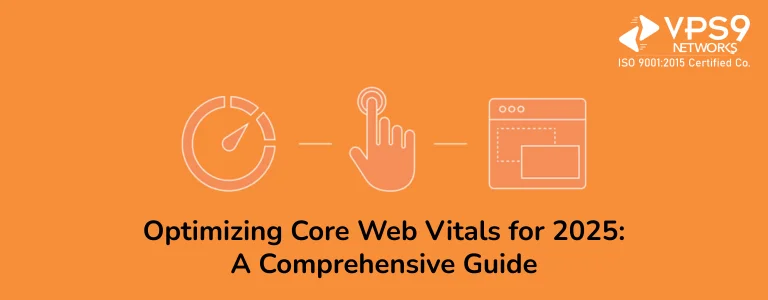Table of Contents
- Introduction to Core Web Vitals
- Why Core Web Vitals Matter in 2025
- Key Metrics of Core Web Vitals
- Largest Contentful Paint (LCP)
- First Input Delay (FID) and Interaction to Next Paint (INP)
- Cumulative Layout Shift (CLS)
- How to Measure Core Web Vitals
- Strategies for Optimizing Core Web Vitals
- Advanced Techniques for Web Performance Optimization
- The Role of AI and Automation in Web Performance
- Future Trends in Core Web Vitals and Web Performance
- VPS9 Networks: Enhancing Web Performance through Premium Hosting Services
- Conclusion
Introduction to Core Web Vitals
Why Core Web Vitals Matter in 2025
Key Metrics of Core Web Vitals
- Largest Contentful Paint (LCP)
- First Input Delay (FID) and Interaction to Next Paint (INP)
- Cumulative Layout Shift (CLS)
How to Measure Core Web Vitals
Strategies for Optimizing Core Web Vitals
Advanced Techniques for Web Performance Optimization
The Role of AI and Automation in Web Performance
Future Trends in Core Web Vitals and Web Performance
VPS9 Networks: Enhancing Web Performance through Premium Hosting Services
- Overview of VPS9 Networks
- Managed VPS Hosting
- Self-Managed VPS Hosting
- Cloud VPS Hosting
- Dedicated Servers
- Streaming Servers
- SSL Security and DDoS Protection
- 24/7 Customer Support and Website Migration Services

In today’s digital landscape, website performance directly impacts user experience, engagement, and SEO rankings. Google’s Core Web Vitals are now the industry standard for assessing the performance of websites in the real world, having a direct impact on conversion rates and search engine results. As we approach 2025, optimising these KPIs is critical for businesses, developers, and SEO experts. The focus of Core Web Vitals is three key areas: visual stability, interactivity, and loading speed. By lowering bounce rates and improving visitor retention, these components contribute to a flawless user experience.

Google’s user-first approach makes Core Web Vitals optimisation essential. Websites that don’t adhere to these guidelines run the danger of losing their audience, visitors, and revenue. In a competitive digital space, loading speed, responsiveness, and stability can make or break a website. The requirement for optimisation has increased due to Google’s increasingly complex algorithms and mobile-first indexing. Accessibility, speed, and ease of use are now essential for companies looking to maintain their top search engine rankings.

LCP measures how quickly the largest visible element, such as an image or block of text, loads on a page. An LCP score under 2.5 seconds is ideal; slower times lead to higher bounce rates and poor engagement. Slow LCP can be caused by unoptimized images, poor server response times, render-blocking JavaScript, and excessive CSS.
FID measures the time between a user’s first interaction, like clicking a button, and the browser’s response. In 2025, Interaction to Next Paint (INP) is replacing FID as a broader measure of responsiveness. INP measures overall page responsiveness, ensuring smooth, lag-free interactions.
CLS evaluates the stability of elements on a page as they load. A low CLS score ensures that users do not experience unexpected layout shifts, which can be frustrating and detrimental to the overall user experience. Pages with ads, dynamically loaded content, or late-loading fonts often suffer from poor CLS scores
To optimize website performance, it is essential to measure Core Web Vitals using reliable tools. Google provides several options, including Google PageSpeed Insights, Lighthouse, and Chrome DevTools. The Google Search Console Core Web Vitals report gives insights into areas that require improvement. Webmasters and developers can also use WebPageTest and GTmetrix to analyze performance data and identify optimization opportunities.
A planned approach is needed to improve Core Web Vitals, which includes optimizing images, reducing JavaScript execution, and improving server performance. Using next-generation formats like AVIF and WebP, optimizing and compressing pictures, implementing lazy loading, and utilizing CDNs and effective web hosting options to decrease server response time are all essential for achieving a quick LCP.
In order to improve INP (formerly FID), JavaScript execution time must be decreased. For sophisticated computations, websites must use web workers, optimize event listeners, and eliminate unnecessary third-party scripts. Delays can also be minimized by implementing asynchronous loading and browser caching.
Websites must specify the width and height of images and media items explicitly in order to keep a low CLS. In order to prevent layout changes, developers should make sure fonts load quickly and refrain from dynamically adding material above already-existing items.

Server-side rendering (SSR) and static site generation (SSG) are two advanced methods that can greatly improve page speed for businesses looking to achieve optimal website performance. Interactivity can be significantly enhanced via code splitting, in which only necessary JavaScript is loaded first.
Preloading and prefetching resources to predict user behavior and proactively distribute content is another important consideration. Web performance is further optimized by browser caching and compression methods like Gzip and Brotli, which decrease pointless queries and speed up loading times.
Automation and artificial intelligence are transforming website optimization. With minimal human involvement, AI-driven systems may evaluate performance data and recommend optimizations. In order to provide a smooth experience, commonly requested content might be preloaded using machine learning algorithms that predict user behavior.
The web optimization landscape is always evolving. Real-time tracking of performance is going to be crucial in 2025 and beyond to make sure a website stays competitive. Since mobile traffic is now higher than desktop usage, mobile optimization remains a major focus. The adoption of progressive web apps (PWAs), which give users app-like experiences while preserving online accessibility, is growing in popularity.
VPS9 Networks is a leading provider of high-performance web hosting solutions, offering reliable VPS hosting, dedicated servers, and cloud hosting. With global server locations and advanced security measures, VPS9 Networks ensures optimal website performance and uptime.
Services Offered by VPS9 Networks
Conclusion
Businesses must optimize Core Web Vitals if they want to increase conversions, enhance user experience, and retain high search rankings. Using the best web hosting company, like VPS9 Networks, will ensure long-term success in the digital age and greatly improve performance.



